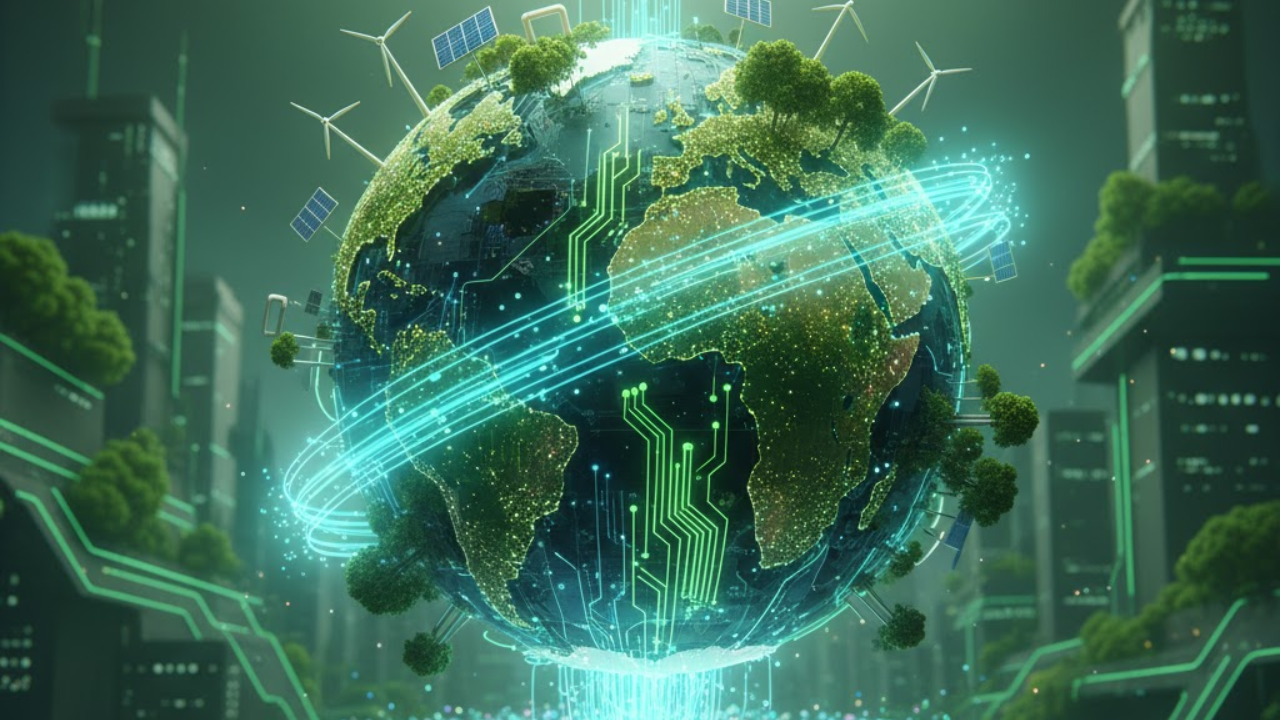
Post by : Naveen Mittal
The smallest technologies are now tackling the world’s biggest problems. From powering electric vehicles to cleaning polluted water, nanotechnology — engineering at the scale of billionths of a meter — is emerging as one of the most powerful tools in the global sustainability revolution.
In 2025, nanotech isn’t just a scientific concept confined to research labs; it’s fueling real-world breakthroughs across energy, materials, and environmental technology — quietly shaping a cleaner, smarter planet.
Nanotechnology manipulates matter at the atomic and molecular level — a scale so small that 100,000 nanometers fit into the width of a human hair.
This extreme precision allows scientists to engineer materials with extraordinary properties:
10x stronger than steel but lighter than aluminum.
Highly conductive yet flexible.
Capable of self-repair or absorbing pollutants.
These materials are unlocking innovations across energy storage, clean manufacturing, green construction, and sustainable fuel production — the pillars of the next-generation green economy.
One of the most transformative areas of nanotech is energy generation and storage.
Traditional solar panels capture only part of the light spectrum. Using quantum dots and perovskite nanomaterials, scientists are now building ultra-efficient solar cells that can absorb both visible and infrared light.
Recent experiments with graphene-based coatings have shown a 40% increase in photovoltaic efficiency, while remaining flexible enough to be used on rooftops, vehicles, or even wearable devices.
Energy storage has long been the bottleneck of renewable adoption. Nanotech is solving this with lithium-silicon and solid-state nanostructures that can:
Charge 5x faster.
Last 3x longer.
Operate safely under extreme conditions.
Companies like Tesla, CATL, and QuantumScape are integrating nano-engineered electrodes into next-generation EV batteries, promising lighter cars and longer ranges.
Nanocatalysts — particularly platinum nanoparticles and carbon nanotube membranes — are making hydrogen fuel cells more efficient and affordable by lowering reaction barriers.
This could accelerate the transition toward zero-emission transport and industrial hydrogen production.
Nanotechnology is rewriting the rules of materials science. The result? Substances that are lighter, tougher, and more sustainable than anything humans have ever created.
By embedding nano-silica and bacteria-based nanocapsules, researchers have created concrete that automatically fills cracks when exposed to moisture — extending infrastructure lifespan and cutting maintenance costs.
Buildings coated with titanium dioxide nanoparticles can break down pollutants and kill bacteria when exposed to sunlight. These coatings are already being used in hospitals, airports, and city walls across Asia and Europe.
The textile industry is turning to nanofiber coatings that repel water, resist stains, and even generate electricity from motion — paving the way for self-powered clothing and wearable electronics.
Nanotechnology is the backbone of many cutting-edge climate and environmental technologies.
Water Purification: Nano-membranes and graphene filters can remove 99.9% of contaminants — from heavy metals to microplastics — while remaining cost-effective for developing countries.
Carbon Capture: Nanoporous materials, like MOFs (Metal-Organic Frameworks), trap CO₂ molecules with unprecedented efficiency, offering a scalable solution for carbon-neutral industries.
Clean Manufacturing: Nanocatalysts allow factories to perform chemical reactions at lower temperatures, reducing energy consumption and emissions by up to 50%.
These applications make nanotech a cornerstone of the United Nations Sustainable Development Goals (SDGs) — particularly for clean water, affordable energy, and responsible production.
According to Allied Market Research, the global nanotechnology market is expected to exceed $450 billion by 2032, growing at a CAGR of 33%.
Within that, energy and environmental nanotech make up one of the fastest-growing segments.
Countries like the U.S., China, Japan, and Germany are leading R&D investments, while startups in India, South Korea, and Singapore are developing affordable nanotech-based climate solutions.
Nanotechnology isn’t just for scientists — it’s quietly integrating into everyday life:
Smartphone batteries that charge in minutes using nanostructured anodes.
Transparent solar films on windows that generate electricity.
Nanocoated wind turbine blades that resist corrosion and boost power generation.
Eco-friendly paints and packaging made with biodegradable nanocomposites.
By 2030, it’s estimated that nearly 70% of green technologies will incorporate some form of nanomaterial or nanoscale engineering.
Nanotechnology is proving that sustainability and performance don’t have to compete — they can coexist at the molecular level.
Its impact stretches far beyond science; it’s reshaping global industries, climate policies, and even urban design. From cleaner energy to smarter infrastructure, nanotech is making the invisible visible — one atom at a time.
As materials get smaller, our potential for a greener future grows exponentially.
Nanotech isn’t just a buzzword — it’s the foundation of the next industrial revolution.
In 2025, it stands at the intersection of innovation and sustainability, empowering a world where energy is cleaner, materials are smarter, and progress is measured not by size — but by impact.
As one researcher from MIT put it: “Nanotechnology won’t just change how we build — it will change what’s possible.”
And that, at the smallest scale, could make the biggest difference of all.










Paramount+ Wins Five-Year Deal to Stream PBR’s 'Unleash the Beast'
Paramount+ has inked a five-year streaming agreement to carry PBR's Unleash the Beast live from Dece

Zohran Mamdani's Historic NYC Win Marked by Bollywood Finale
Zohran Mamdani captured the New York mayoralty — the city's first Muslim and South Asian mayor — and

Indian Tennis Veteran Rohan Bopanna Ends Illustrious Career
Rohan Bopanna retires from tennis at 45 after winning two Grand Slams, becoming world number one, an

Babar Azam Becomes Top Run Scorer In T20I Cricket History
Pakistan’s Babar Azam has overtaken India’s Rohit Sharma to become the highest run-scorer in men’s T

BTS Comeback 2026 Group Plans Biggest-Ever Global Tour
BTS is set for a long-awaited comeback in 2026, followed by a massive 65-city world tour. Fans hope

India Stuns Australia to Reach Women’s World Cup Final
India shocked seven-time champions Australia in the Women’s World Cup semi-final, chasing 339 runs w